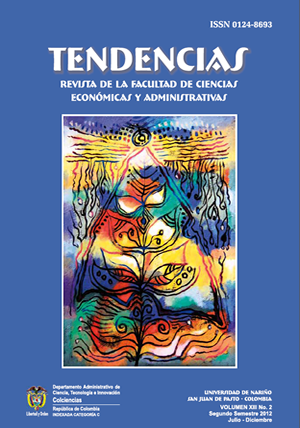UN MODELO DE GASTO PÚBLICO LOCAL: RECONSIDERANDO EL MODELO DE TIEBOUT
Palabras clave:
Local Public Expenditure, Tiebout Hypothesis, Fiscal Decentralization, Efficiency, DistributionResumen
La teoría del gasto público local se concibe formalmente desde la hipótesis de Tiebout en 1956. La consideración de un mecanismo para la revelación de las preferencias por bienes públicos introdujo un argumento estrictamente teórico a favor de la descentralización fiscal. Este trabajo parte de la hipótesis de Tiebout para examinar las condiciones bajo las cuales sigue siendo válida analíticamente. A partir de la formalización matemática, se propone un modelo teórico de gasto público local, que analiza íntegramente, los condicionantes de un gobierno descentralizado en términos de sus funciones de asignación y distribución.Descargas
Citas
Brueckner, J. (2001). Fiscal decentralization with distortionary taxation: tiebout vs tax competition, Institute of Government and Public Affairs, University of Illinois at Urbana-Champaign.
Buchanan, J. (1965). An economic theory of clubs. Economica, New Series, Vol. 32, Nº. 125.
Bucovetsky, S., M. Marchand, and P. Pestieau (1998). Tax competition and revelation of preferences for public expenditure. Journal of Urban Economics Nº 44. pp. 367–390.
Camelo, M. (2009). Sobre el desarrollo de la teoría de los bienes públicos locales. Revista Finanzas y Política Económica, Vol. 1, N° 2, 2009.
Epple, E & Romer, T. (1991). Mobility and redistribution. The Journal of Political Economy, Vol. 99, No. 4 (Aug., 1991).
Hanushek, E. & Yilmaz, K., (2007). The complementarity of Tiebout and Alonso. Journal of Housing Economics 16.
Henderson, J. V., (1979). Theories of group, jurisdiction, and city size. Current issues in urban economics. P. Mieskowski & M. Straszheim (eds). The Johns Hopkins University Press, Baltimore.
Hochman, O., D. Pines, & J.F. Thisse (1995). On the optimal structure of local governments. American Economic Review 85.
Kornai, Janos, Eric Maskin, & Gerard Roland, (2003). Understanding the soft budget constraint. Journal of Economic Literature (Vol. 41), Diciembre.
Lindahl, E. R. (1919). Die gerechtigkeit der besteuerung. Traducido al idioma inglés como: “Just taxation a positive solution”, en Musgrave, R., & Peacock, A. (1958). Classics in the theory of public finance, pp: 168- 176. Macmillan, New York.
Mansoorian, A., and G. M. Myers (1993). Attachment to home and efficient purchases of population in a fiscal externality economy. Journal of Public Economics Nº. 52.
Musgrave, R. (1939). The voluntary exchange theory of public economy. Quarterly Journal of Economics. Vol. 53 – Febrero.
Oates, W, E., (2001). Property taxation and local government finance. Cambridge, Massachusetts: Lincoln Instituteof Land Policy.
Oates, W, E., (2006). The many faces of the Tiebout model. the Tiebout model at fifty, ed, William A. Fischel. Cambridge, MA: Lincoln Institute of Land Policy.
Oates, W, E., (2008). On the evolution of fiscal federalism: theory and institutions. National Tax Journal, Vol LXI, Nº 2.
Pauly, M, (1973). Income redistribution as a local public good, Journal of Public Economics, 2.
Pauly, M., (1976). A model of local government expenditure and tax capitalization. Journal of Public Economic. Octubre, Vol. 6.
Peng S.K., & Wang, P, (2005). Sorting by foot: ‘travel-for’ local public goods and equilibrium stratification. The Canadian Journal of Economics, Vol. 38, No. 4.
Perroni, C., & Scharf, K, A. (2001). Tiebout with politics: capital tax competition and constitutional choices. The Review of Economic Studies, Vol. 68, No 1.
Rhode, P, W., & Strumpf, K, S. (2003). Assessing the importance of tiebout sorting: local heterogeneity from 1850 to 1990. The American Economic Review, Vol. 93, No. 5.
Rubinfeld, D, (1987). The economics of the local public sector. Handbook of Public Economics, Vol. 2.
Samuelson, P, (1954). The pure theory of public expenditure. The Review of Economics and Statistics, Vol. 36, No. 4.
Samuelson, P. (1955). Diagrammatic exposition of a theory of public expenditure. The Review of Economics and Statistics, Vol. 37, No. 4.
Scotchmer, S. (1994). Public goods and the invisible hand. Modern Public Finance. Cambridge, MA: Harvard University Press.
Starrett, D. A, (1980) Measuring externalities and second best distortions in the theory of local public goods. Econométrica, Vol. 48, No. 3.
Stiglitz, J, (1977). The theory of local public goods. The Economic of Public Services. M. S. Feldstein y R. P. Inman (eds.), McMillan, Londres, 1977. Tax Journal Vol. LIV, No. 3
Tiebout C, (1956). A pure theory of local expediture, The Journal of Political Economy, Vol. 64, No. 5. (Oct., 1956).
Wallis, J. & Barry R., (2008). Dysfunctional or optimal institutions: state debt restrictions, the structure of state and local governments, and the finance of american infrastructure. fiscal challenges: an interdisciplinary approach to budget policy. Ed Garret, Graddy. New York: Cambridge University Press.
Wellisch, D. (1994). Interregional spillovers in the presence of perfect and imperfect household mobility. Journal of Public Economics Nº 55.
Wellisch D, (2004). Theory of public finance in a federal state. Cambridge University Press.
Wildasin, D., (1997). Externalities and bailouts: hard and soft budget constraints in intergovernmental fiscal relations. Mimeo.
Wildasin, D., (2004). The institutions of federalism: toward an analytical framework. National Tax Journal, 57 No. 2 (Junio).
Wilson, J. D. (1995). Mobile labor, multiple tax instruments, and tax competition. Journal of Urban Economics Nº 38.
Yinger, J. et al. (1988). Property taxes and house values: the theory and estimation of intrajurisdictional property tax capitalization. Boston: Academic Press.
Zodrow, G. R. & Mieszkowski, P. (1986). Pigou, Tiebout, property taxation and the under-provision of local public goods. Journal of Urban Economics, Vol. 19.
Descargas
Publicado
Cómo citar
Número
Sección
Licencia
Aquellos autores/as que tengan publicaciones con esta revista, aceptan los términos siguientes:
Esta revista está bajo una Licencia Creative Commons Reconocimiento-NoComercial 4.0 Internacional License. Los artículos se pueden copiar, distribuir, adaptar y comunicar públicamente, siempre y cuando se reconozcan los créditos de la obra y se cite la respectiva fuente. Esta obra no puede ser utilizada con fines comerciales.
Para aumentar su visibilidad, los documentos se envían a bases de datos y sistemas de indización.
El contenido de los artículos es responsabilidad de cada autor y no compromete, de ninguna manera, a la revista o a la institución.







































